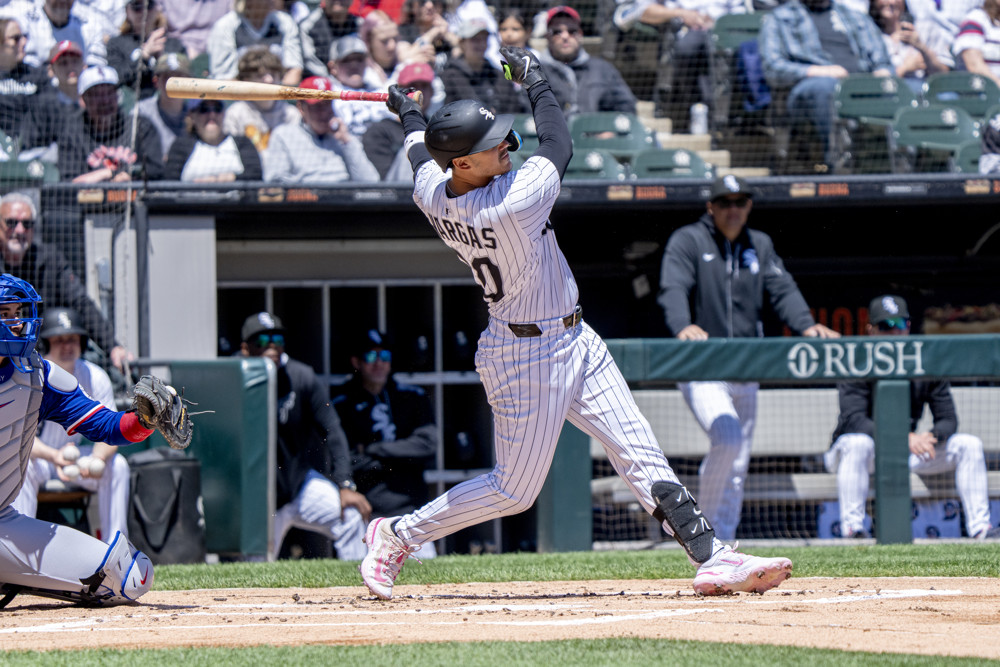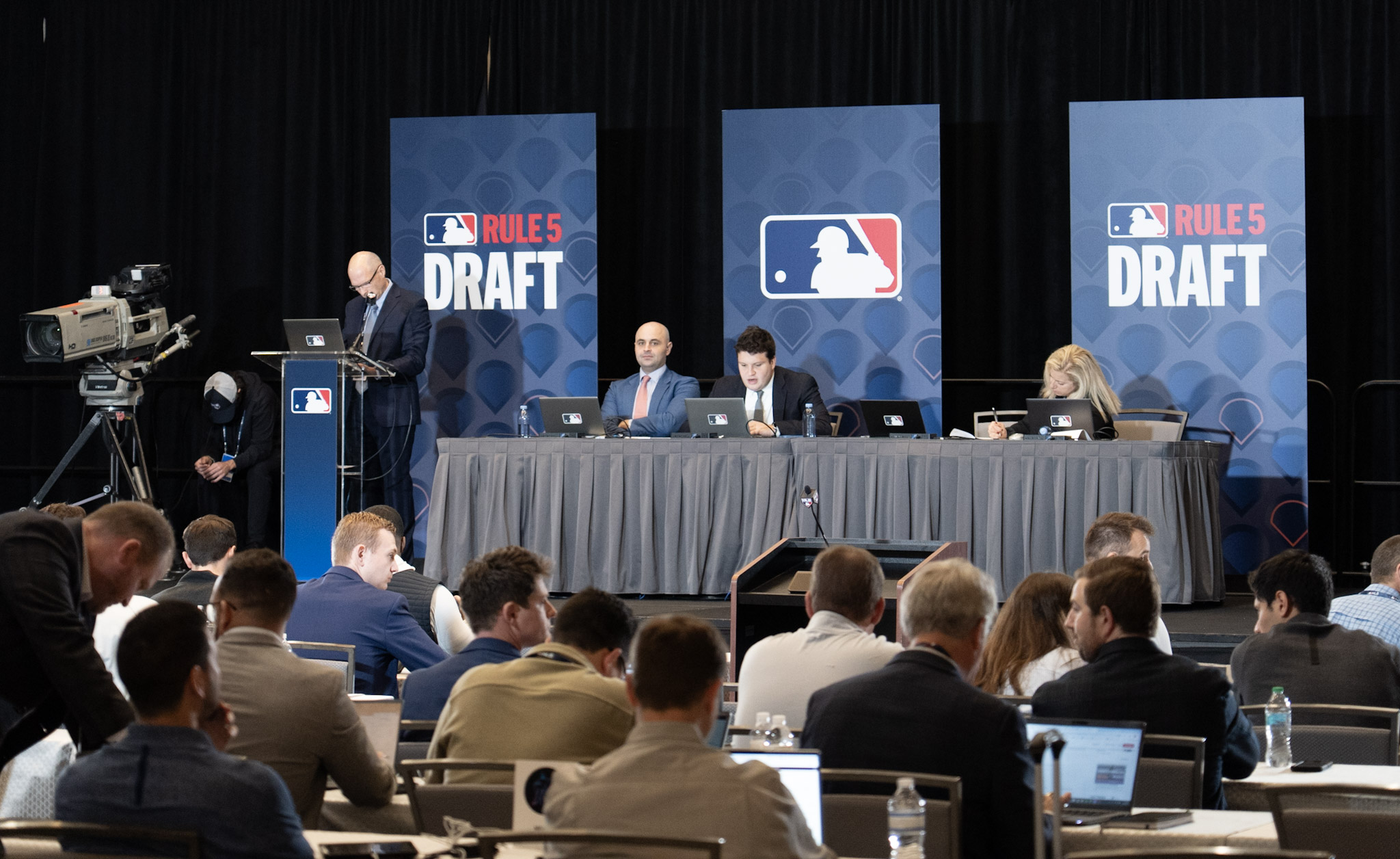The White Sox have dropped eight of their last nine games, so it's time to do what's usually done in times like these: gaze out to the future and consider different problems.
Chris Getz's open-ended brand of answers last Wednesday purposely didn't telegraph a direction on several pending roster decisions, but perhaps are more easily understood if we lay out the issues putting pressure on every position group.
Or perhaps not, but it will provide something to debate while we pass our remaining time on Earth.
Catchers
The question of whether Kyle Teel and Edgar Quero can coexist as they both track toward becoming above-average offensive catchers is the more compelling one, and Getz's allusion to "opportunity to repurpose some of these players to help in other areas," is enough fuel to keep us warm with trade speculation through the winter.
Of course, Getz is no stranger to holding onto a player when the world demands a deal, and compared Garrett Crochet and Luis Robert Jr., there are no time pressures nor economic concerns to negotiate. It's more that Getz said "catching is gold" after landing Teel in the winter meetings, and residents of the middle and lower classes more often use gold to buy things than stockpile it.
The more immediate pressure on this group is that Korey Lee will be out of options next spring, making his late-season tenure as the third catcher on the roster into an audition, since the Sox will not be able to stash him in Triple-A next season without exposing Lee to waivers. In that light, Lee's recent dalliance with an inverted Isiah Kiner-Falefa development path reads as probing whether such an arrangement could work without expanded rosters as an aid.
"Korey, he's athletic, just as athletic as anyone on a field," Getz said. "He's been taking balls in the outfield, he takes his ground balls on the infield. Is he going to become a regular at those positions? I doubt it. However, it speaks to his ability to play baseball and to help a team win. It's been nice having him up here as a third catcher, because it's allowed us to get some extra at-bats and playing time for the others. But as we continue to assess everything and try to find ways to improve this club, we're open-minded in how to take advantage of the catching role."
Infield
Since both able to play shortstop with complementary spots they can rotate to, Colson Montgomery and Chase Meidroth are pretty compatible for carrying on a roster together. It's the corners where there's more conflict.
Miguel Vargas, Lenyn Sosa, Curtis Mead and Bryan Ramos will all be out of options by next spring, and that reads as at least one right-hander corner infielder too many for an organization that's been prioritizing a balanced attack in terms of handedness. Getz & Co. have consciously prioritized up-the-middle players, not viewing first basemen or single-inning relievers as fabulous uses of resources. Relatedly, even endorsements of Vargas and Sosa -- the clear leaders of this pack -- come couched with qualifiers.
"There’s another step forward that [Vargas] can make and he’s got the makeup to attack it in the right way to help his own game, to help our team," Getz said. "Lenyn has done a really nice job in the box, he has. He’s hit for power, he’s gotten big hits for us. He needs to continue to develop on the defensive side. He’s played some first base, some second base as well. He needs to maintain that versatility and ability to play other positions beyond first base or DH. That’s something, conversations we’ve had with him and will drive forward this offseason. These guys have taken steps forward, they have. But both of them I feel can take another step for us."
Getz has mentioned Mead as an option for second base in the past, but he's yet to appear anywhere beyond first and third for the White Sox. At any position, Mead's above-average raw power has not shown up in games yet (.328 slugging) at the level necessary to carry his profile. Upon acquiring Mead, Sox officials talked about their desire to give him a consistent offensive plan to counter his penchant for tinkering, which certainly reads as an offseason project at his juncture.
Does that project take precedence over providing any major league runway for Bryan Ramos, whose path to Chicago has been complicated by two years of injuries and struggles against right-handed pitching? He's the only one without a big league roster spot, so it would be overcomplicating it to conclude anything other than Ramos being the likely odd man out. But there isn't an established franchise cornerstone among the four, so the Sox can at least consider possibilities for clearing the glut from either direction.
Outfield
Even with Andrew Benintendi under contract for another two years and Getz committing again to picking up Luis Robert Jr.'s option -- and quite unlikely to find a better trade market for Robert this winter -- the Sox outfield has more of the opposite issue.
Brooks Baldwin, Will Robertson and even Dominic Fletcher all have options remaining for next season (Fletcher was designated for assignment in the spring 10 days after he was optioned, before he could hit the 20 days on optional assignment necessary to burn his final option year. Even if Fletcher clearing waivers makes such a benefit seem extraneous, knowing this minutiae will astound your friends/half-listening significant other). Dru Baker, brought over in the Matt Thaiss trade, is Rule 5 eligible this winter, but never built a great case for why his fourth outfielder ceiling should be prioritized over that of others.
With none of those players demanding a roster spot, the Sox seem more likely to have outfield openings than an unwieldly surplus of applicants. Michael A. Taylor is headed toward free agency on the heels of a poor second half offensively, and no Sox leadership figure seems willing to commit to something as seemingly low stakes as making a tender offer to Mike Tauchman for his final year of arbitration-eligibility.
"It's good for our clubhouse to see a guy at this stage of his career, fight the way that he does," Getz said. "We'll have our conversations with Tauch and his group and certainly openminded in bringing him back in some capacity."
"He’s been a massive impact on our group," Will Venable said. "Obviously he’s performed very well, so absolutely, any club would be lucky to have Tauch on the roster."
If building a right field platoon of Tauchman and Austin Slater for less than $4 million combined was meant as a demonstration of more cost-effective ways to fill a corner outfield spot, this winter might need to be a demonstration of how to savvily fill out the depth of two corner spots. There probably wasn't any remaining desire/illusions to have Benintendi man 100+ games in left field, but him managing leg issues for the second-straight season is a reminder of why there shouldn't be.
Even at a Baldwinist publication like this one, it's hard to spin a season with as many defensive foibles and chase issues as the 24-year-old dealt encountered with much more than "let's see how he looks in spring." If anything, it's easy to look at this current group and imagine that Braden Montgomery having a monster big league camp next March would drive a lot enthusiasm for having his progression accelerated.
Starting rotation
With Martín Pérez heading to free agency after an injury-ravaged 2025, Jonathan Cannon in the minors and Sean Burke's last six-inning outing coming prior to Independence Day, it takes some rhetorical gymnastics to claim there are safe projections for the 2026 rotation outside Shane Smith and Davis Martin. Yoendrys Gómez is also out of options, so he should have ample room to compete for a rotation spot as well, since his consolation prize is likely still a major league job.
"There's going to be a lot of talented arms that are already ready for Triple-A or the big leagues and almost not enough roster spots," said Brian Bannister. "When you look at guys coming back, the heavy discussions are going to be how do we get the most out of everybody. How do we help everybody reach their ceilings? And how do we maximize their skill set? So I think you'll see some guys go into shortened roles, really to just take advantage of their present stuff. And also we're going to have to be smart with workloads, guys coming back from surgeries. There's probably piggybacking scenarios in there where we limit their innings early on and we throw two pitchers, two starters in one game, where we throttle their workloads a little bit."
With respect to Bannister, I don't see the bottleneck he's foreseeing to be as imminent as it may sound. For all the Tommy John surgeries suffered last spring (Ky Bush, Prelander Berroa, Drew Thorpe, Juan Carela, Blake Larson, Mason Adams), Bush is the only one who underwent surgery early enough to hold out much hope of him being relevant to the big league roster in the opening months of the season, and he probably needs to shove in the minors again post-surgery before a bump in responsibility comes in response.
Bannister acknowledged 22-year-old Tanner McDougal as "a guy that's going to have to be protected," from the Rule 5 draft, but also someone who "proved that he's a starter for now." So he'll both be in big league camp hawking his wares, but building toward a role that probably needs more development time. Other starting pitching Rule 5 eligibles (Shane Murphy, Duncan Davitt, Tyler Schweitzer, a likely out until midseason Adams) are likely more big league ready, but have less stirring long-term cases for protection.
Even if there wasn't persistent chatter of Grant Taylor returning to starting as soon as next season, every Sox official refusing to give a definitive answer on his immediate future over the past week would fuel it. Alongside the answers on Tauchman, White Sox leadership has shown impressive messaging discipline over the past week, which always seems trivial unless you've recently experienced life without it.
Getz openly said that he had once hoped for Noah Schultz and Hagen Smith to compete for roster spots in spring of 2026 before injuries and under-performance stalled their momentum. It's feasible to see a strong finish through the AFL for Smith, alongside strong springs for Cannon and Burke, or Gómez, all producing good rotation candidates. But it's also no wonder that Sox leadership is speaking openly about adding veteran free agent starters.
Bullpen
Tyler Gilbert exhausted his last option season in 2025, which could work in slightly in his favor next spring in a bid to unseat Brandon Eisert to be the one side-arming lefty with more big-league job stability than the others. Owen White will also be out of options, which is a minor point in his favor for trying to claim the Tyler Alexander mop-up role, since the lefty is currently the only pending free agent in the bullpen. Bryan Hudson and Elvis Peguero, both claimed off waivers from the Brewers, will also be out of options but are also ending rocky 2025 campaigns on the injured list.
Ben Peoples ended the season on the IL after coming over in the Adrian Houser trade, but probably still has second billing behind Peyton Pallette among relief prospects who are Rule 5 eligible, and both would be positioned to compete for a job on the Opening Day roster next spring assuming they're retained through the winter.
In general, the White Sox bullpen is admirably outfitted to be interchangeable, but also their bigger problem is adding more talent, not finding a way to fit it in.
That also applies to the team as a whole, where the mainstays are either wrapping up their first full major league seasons or rehabbing a Grade 2 hamstring strain, but now we have the parameters in which to argue all winter.






